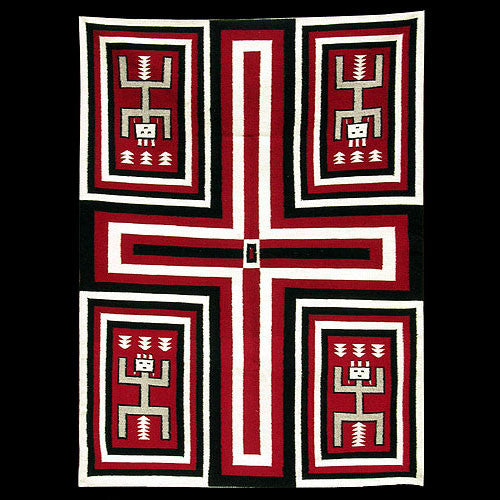



Navajo Four Directional Yeis Rug - Jean Yazzie (#003)
$2,250.00
Artist: Jean Yazzie
A yei’i is a Navajo holy person. As early as the mid-1800’s, Navajo weavers were placing pictorial elements into their weavings. Yei’i figures first appeared in Navajo weavings before the turn of the twentieth century. Considered highly controversial because of their sacred imagery, Navajo weavers nonetheless persisted in incorporating these religious figures into their rugs.
Four areas of influence contributed to the development of Navajo yei and yeibichai weavings. In the early 1900’s, Yanapah, a Navajo weaver married to trader Richard Simpson and living near Farmington, New Mexico, started weaving large single and double figure vertical yei rugs.
Another area of influence in northwest New Mexico came from the Newcomb Trading Post’s partnership with a prominent medicine man named Hastiin Klah who was responsible for the creation of rugs depicting Navajo sandpainting designs. Highly controversial because of their sacred depictions, Klah’s weavings nonetheless had a tremendous influence on weavers of that area and eventually weavers in northwest New Mexico started weaving sacred figures and other design elements into their own Navajo rug creations.
In the early 1920’s, traders in the Lukachukai, Arizona and Shiprock, New Mexico area were encouraging weavers to create multiple figure yei weavings. These early Navajo yei weavings typically had a white or other light-colored background and used a plethora of aniline-dyed yarns for the creation of the yei figures.
Today, this popular style of weaving graces many a fine collection of Navajo rugs. The difference between a yei and yeibichai weaving depends on the depiction of the holy Navajo beings. Yei weavings tend to have static, front facing figures, depicted either singly or more frequently with multiple figures in a horizontal row often surrounded on three sides by a single rainbow yei.
Yeibichai weavings depict the actual ceremonial dance performed in the winter months. An elaborate nine day ceremony, it features male and female yei’i, Talking God, the water sprinkler, fringe mouth yei’i, medicine men and patients. All or some of the above mentioned deities and people will appear in a yeibichai weaving, typically in a more animated form to portray the dancing of the yei during the ceremony.
Yei
Every creature, every aspect of nature has its holy people . . . . even the stinkbug. Sometimes you can see them, if only for an instant. They are represented, some of them, by colors: the blue sky, the evening dusk, the night these are holy people and one prays to them. There are iron people, crystal people, then the other rocks "and such people." There are dawn people, twilight people, air, thunder, and cloud people. One does not talk about such things in nature when they and their holy people are present.
More about this legend
Weaving
After the medicine woman told the people about the prayersticks she told them that there was a place in the underworld where two rivers crossed. It was called ni tqin'kae tsosi, fine fiber cotton (Indian hemp). There were two persons who brought the seed of that plant, they were spiders. They said that the people were to use the plant instead of skins for their clothing. So this seed was planted in the earth? More about this legend
